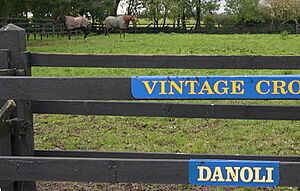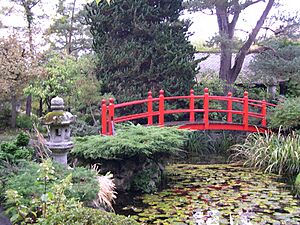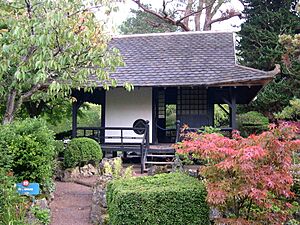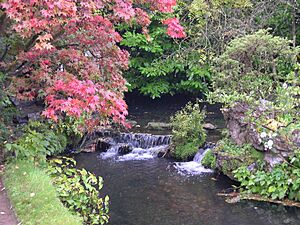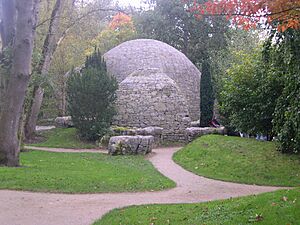Irish National Stud facts for kids
The Irish National Stud is a special place in County Kildare, Ireland. It's where beautiful Thoroughbred horses are bred. The official name is Comhlacht Graí Náisiúnta na hÉireann Teo.. The Irish Government owns this facility. It was officially started on April 11, 1946.
Contents
History of the Irish National Stud
Creating the Japanese Gardens
The amazing Japanese Gardens at Tully were built between 1906 and 1910. A rich Scotsman named Colonel William Hall-Walker designed them. He came from a famous brewery family. A Japanese craftsman, Tassa Eida, and his son Minoru, laid out the gardens. Tassa and his family lived nearby while they worked.
Tassa Eida stayed at Tully until 1911. Then, he and his family moved to London to create another garden. Tassa died in 1912 on his way back to Japan. Years later, in the late 1980s, Tassa's grandson, Brian Eida, visited the gardens. He came as a tourist to see his grandfather's work.
Minoru the Racehorse
Colonel Hall-Walker named his favorite horse "Minoru." This name means 'light of my eye' or 'the favorite one' in Japanese. King Edward VII leased Minoru for racing. In 1909, Minoru won the famous Derby race. People cheered loudly for the King and his horse.
The Stud Becomes National
In 1915, Colonel Hall-Walker moved to England. He gave his entire Tully property to "The Nation." His horse farm became the British National Stud. The Japanese Gardens were not well-known for a while. In 1943, the Tully properties returned to the Irish Government.
The Irish National Stud Company was formed in 1945. The next year, in 1946, the Japanese Gardens got a new supervisor. This was after 34 years without one.
Visiting the Irish National Stud
Explore the Stud Farm
You can take guided tours at the visitor center. Here, you can learn all about horse breeding. You might even see some future champions!
Discover the Japanese Gardens
These gardens are famous around the world. Many people say they are the best Japanese Gardens in Europe. They show how Eastern and Western cultures can blend beautifully.
The gardens tell the story of a person's life. It's like a journey from birth to old age. You walk through paths that show different choices in life. These include paths for learning, marriage, or a peaceful life. The gardens show how people achieve goals and grow old happily. They even show a gateway to eternity.
The journey begins at a special gate. You enter among trees and find a small cave. This cave represents birth. A winding path shows the years of childhood. Then, you reach a rock mound. A tunnel through the rock leads from darkness to light. This means going from not knowing to gaining knowledge.
Halfway through, steps lead to the hill of learning. An old fir tree crowns this hill. Sometimes, students look too high, but a hidden hole teaches them to be careful. After this, they come down to meet others.
The path continues, guarded by rocks. You reach a point where paths split. One path is for ambition, another for a simple life. The middle path leads to married life. This path takes you to a tiny island of joy. You cross stepping stones to explore. But you cannot stay there forever.
All paths eventually lead to a stone bridge. Beyond it are a bamboo bridge and a geisha house. Further on is the hill of ambition. The well of wisdom is visible across the water. The hill is steep, and climbers might separate. But they help each other and unite at the top.
Finally, you cross an easy bridge over roaring waterfalls. You walk on stepping stones through a peaceful garden. This leads to the hill of mourning. From there, your soul passes through the gate of eternity.
St. Fiachra's Garden
This garden opened in 1999 to celebrate the Millennium. It honors St. Fiachra, who is the patron saint of gardeners. It's a peaceful place to enjoy nature.
The Horse Museum
The horse museum at the Irish National Stud has interesting exhibits. You can see the skeleton of the famous racehorse Arkle here.
Who Runs the Irish National Stud?
The Minister for Finance of Ireland owns all shares in the stud's company. The Minister for Agriculture appoints the directors, including the Chairperson. Lady O'Reilly, a well-known horse breeder, has been the Chairperson since 1998.
See also
- List of acts of the Oireachtas
- National Stud Act, 1945
- National Stud Act, 1953
- National Stud Act, 1969
- National Stud Act, 1976
- National Stud (Amendment) Act, 1993
- National Stud (Amendment) Act, 2000
- Royal Charger
- The National Stud (England)


